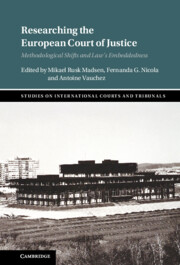Book contents
- Researching the European Court of Justice
- Studies on International Courts and Tribunals
- Researching the European Court of Justice
- Copyright page
- Contents
- Notes on Contributors
- 1 From Methodological Shifts to EU Law’s Embeddedness
- Part I Cases
- Part II Judicial Frames
- 6 Inquiring into Conceptual Practices
- 7 Through the Lens of Language
- 8 A Sense of Common Purpose
- 9 Judge Biographies as a Methodology to Grasp the Dynamics inside the CJEU and Its Relationship with EU Member States
- Part III Socio-legal Practices
- Index
8 - A Sense of Common Purpose
On the Role of Case Assignment and the Judge-Rapporteur at the European Court of Justice
from Part II - Judicial Frames
Published online by Cambridge University Press: 05 May 2022
- Researching the European Court of Justice
- Studies on International Courts and Tribunals
- Researching the European Court of Justice
- Copyright page
- Contents
- Notes on Contributors
- 1 From Methodological Shifts to EU Law’s Embeddedness
- Part I Cases
- Part II Judicial Frames
- 6 Inquiring into Conceptual Practices
- 7 Through the Lens of Language
- 8 A Sense of Common Purpose
- 9 Judge Biographies as a Methodology to Grasp the Dynamics inside the CJEU and Its Relationship with EU Member States
- Part III Socio-legal Practices
- Index
Summary
The chapter deals with the assignment of cases to reporting judges and judicial formations at ECJ. EU lawyers generally consider the ECJ’s system of case assignment to be one of the most problematic features in the court’s decision-making process. They perceive a strong tension with the right to a fair trial. The aim of this chapter is to understand why the court maintains a system that has been under severe attack for a long time. By closely analysing the practice of case assignment between 2003 and 2019, charting assignment profiles of individual judges, the chapter argues that the ECJ’s assignment system is a key mechanism for the court’s institutional success. It has allowed the court to maintain a sense of common purpose, a strong and persistent idea of its mandate as a guardian of the effectiveness and primacy of EU law. The chapter identifies three key functions case assignment performs. First, supporting jurisprudential stability and continuity by creating an elite group of judges who writes the bulk of the most important ECJ decisions. Second, integrating new ECJ judges through gradually assigning them more difficult cases thereby structuring a learning process for becoming a full-fledged ECJ judge. And third, the ECJ’s system of case assignment has helped to maintain what is generally lost in courts of the ECJ’s size: a place where all twenty-seven ECJ judges and eleven Advocates General are informed on all incoming cases, jointly engage in systematizing the ECJ’s case law and framing the court’s agenda.
Keywords
- Type
- Chapter
- Information
- Researching the European Court of JusticeMethodological Shifts and Law's Embeddedness, pp. 187 - 208Publisher: Cambridge University PressPrint publication year: 2022



